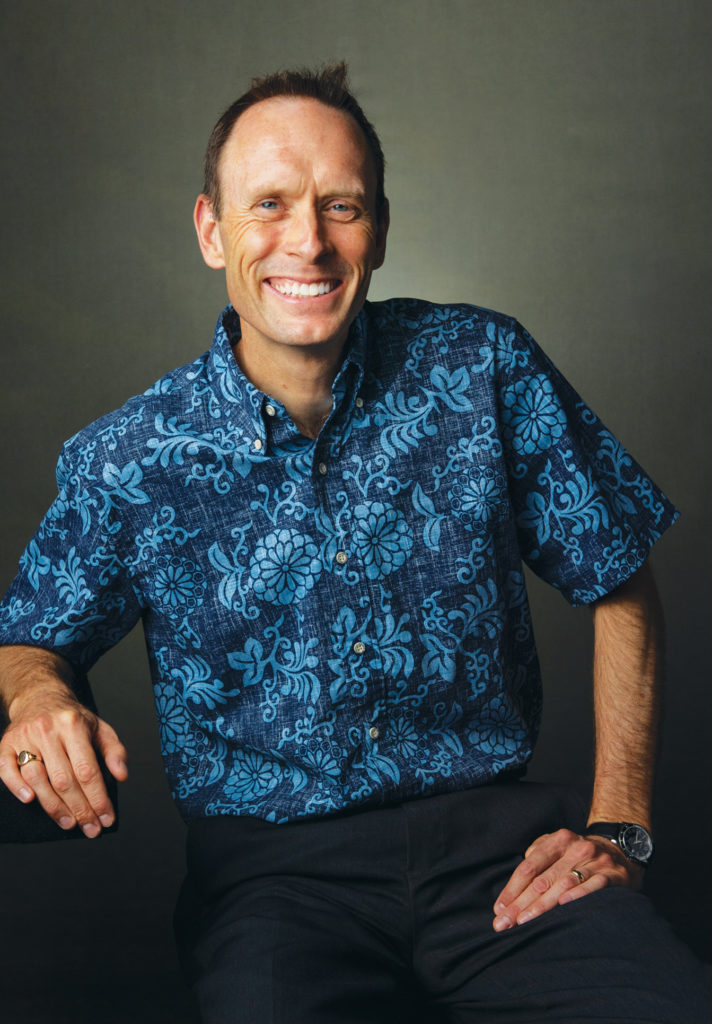By Diane Seo ’85

Mike Latham’s ’86 first days after taking the helm as Punahou’s 17th president unfolded with a swirl of activity – chapels, Convocation, faculty and staff meetings; parent, alumni and Trustee events; as well as numerous campus visits. Everyone wanted to meet Latham, and hear his vision for the School.
Over those weeks in July and August, Latham consistently impressed his audiences. A gifted speaker, he demonstrated a natural ability to synthesize complex thoughts with assurance and clarity. While doing so, he revealed himself as a respectful and thoughtful leader, expressing gratitude for how Punahou steered him to greater heights and a desire to engage with the people he’s been asked to serve. With his broad understanding of education after a distinguished career as a college dean, professor and history scholar, it was clear he spent the months before his Punahou homecoming immersed in the world of the School, framing his thoughts and initial plans.
Stepping into the role held by previous President Jim Scott ’70 for a quarter century, Latham has rooted himself in what he regards as Punahou’s primary mission – to shape students into educated, capable and giving people who have the knowledge and skills to succeed in college, and ultimately contribute to the world.
As such, he has laid out a foundation. His vision draws heavily on his decades-long experience intersecting with thousands of college students and understanding what skills and abilities are needed to thrive. Details and specifics still need to be worked out, and input collected. But Latham has thus far identified three main academic priorities.
First, with the world changing so rapidly, Latham says that as Punahou continues its longstanding excellence in core areas like math, English, and science, it must also prepare students for lifelong, adaptive learning. “Our students will graduate into a world that is very different than our own,” he told faculty and staff at an opening day Chapel. “They will have multiple careers, and we are preparing them for jobs and professions and careers that do not yet exist.”
Because of these shifts, students need to learn how to be adaptable, creative, collaborative and innovative, in addition to acquiring traditional academic knowledge. Punahou’s curriculum, programs and even facilities must encourage this type of learning in both the Junior School and Academy – something that’s already begun through the School’s learning commons, design thinking courses, makeries, Case Accelerator for Student Entrepreneurship, G-Term program and construction of innovative learning environments like the new Kosasa Community for Grades 2 – 5.
Overall, Latham says he’s inspired by what Punahou has initiated, and intends to lead the School forward on all these fronts.

Second, Latham says students need to be able to apply knowledge acquired in multiple disciplines to solve the world’s most pressing problems. He hopes Punahou students ultimately are among those tackling such issues as climate change and food security, drawing upon their education to devise solutions. “All of these deeply complicated and challenging forces, which will transform our world, require that we bring students together, help them draw knowledge from different fields and apply it to these great challenges that stand before them,” he said.
Punahou already has established a base for this type of learning through its Wo International Center, Luke Center for Public Service, Student Global Leadership Institute (SGLI) and Senior Capstone class, where students apply what they learn in social studies and other courses to initiate a community service project. But Punahou can push even deeper to ensure students are prepared for what’s ahead, Latham said.
Finally, Punahou must commit to social, emotional and ethical learning (SEEL) – to educate the whole person. “It’s not enough for us to educate students who are going to be academically brilliant, who are going to nail every standardized test, who are going to get great transcripts. We have to graduate students who are resilient, who are self-confident, who can handle adversity or uncertainty or ambiguity, who can learn to navigate a new and challenging situation,” he said.
After seeing first-hand how students move through higher education, Latham knows that the ability to manage stress and anxiety and be resilient amid difficult times is crucial. “Given that so many of Punahou’s students will in fact go on to the mainland for their education into radically different settings, we have to really help prepare them for that,” he said. “We have to give them the tools and the resources to do that, too … As parents, I think all of us recognize that. This now is also part of the mission of the School.”
Social, emotional and ethical learning will continue to be part of the School’s Junior School curriculum, and a health and wellness curriculum has been added in the ninth and 10th grades. Latham also plans to launch a parent education program to have the School work in partnership with families to build social and emotional skills in students.
Related Article
My Hope for Students: Mike Latham ’86

There are numerous other things on Latham’s mind. His job, after all, is like leading a multi-faceted community, with numerous responsibilities and many different constituencies to serve. He is well aware of all that is expected, what can be realistically accomplished, and what might be envisioned to not just maintain the School’s standing, but to elevate it further.
Punahou’s challenge is to keep advancing in the absence of a crisis. A school like Punahou could have rested on its laurels years ago and stayed where it was, but the School continued to innovate, change and grow, Latham said. He sees his leadership now as a once-in-a-career opportunity to be part of an institution that will continue to be transformative – a challenge he is more than willing to embrace.


